How We
Created Our Environmental Center
Creating
an environmental center on your school grounds is so much fun. It can be
as small as a few garden plots or as extensive as ours is. The first step
is to create a landscape plan. This plan includes the layout of the
gardens. Ours also included where specific plants were to be planted and
other features such as the pond, paths, tables, etc. We had to do a lot of
research in this part of the planning because we had to learn which plants and
trees grew best in our climate and soil, and what type of plants to put in each
of the theme gardens. We have many different types of gardens: an
annual garden, bulb garden, hummingbird garden, butterfly garden, wildflower
garden, vegetable garden, herb garden, earthworm farm, strawberry patch,
perennial garden, and a sunflower garden.
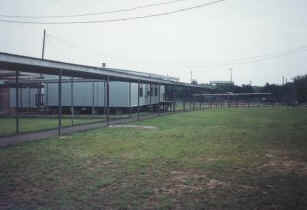 After the
initial landscape plan was created we looked at irrigation. Because our
environmental center was so large, we decided to have an automatic irrigation
system with six zones installed. This gives us control over when to water
and how long we will water each zone. The irrigation system is wonderful
because during the hot, dry summer months, we don't have to worry about someone
watering! The irrigation system was pretty expensive, but well worth
it.
After the
initial landscape plan was created we looked at irrigation. Because our
environmental center was so large, we decided to have an automatic irrigation
system with six zones installed. This gives us control over when to water
and how long we will water each zone. The irrigation system is wonderful
because during the hot, dry summer months, we don't have to worry about someone
watering! The irrigation system was pretty expensive, but well worth
it.
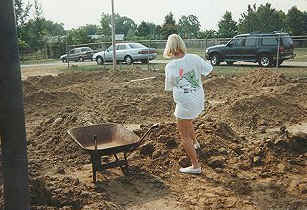
Once the
initial plans were completed we were ready to start the actual
landscaping. We had a parent who owned an asphalt paving company grade the
entire area and put down new topsoil for us. He also dug the pond.
Several weekends were spent with parents and students spreading out the topsoil
and getting everything ready.
The next
step was to build the gardens. We chose to have raised gardens which we
built with landscape timbers. Parent and community volunteers built the
raised gardens. The next
step was to install the irrigation system. We had this professionally
done.
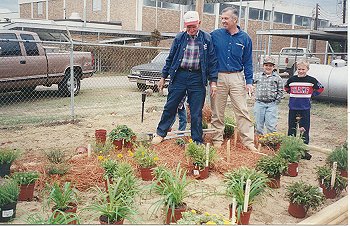
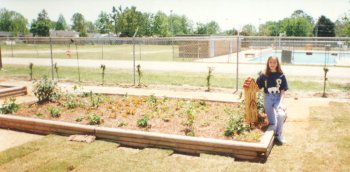
Once the
irrigation system was installed we were ready to start planting! Several
local nurseries "adopted" a garden and came to the school to assist
the students with planting.
After all
the gardens were planted we had the trees and shrubbery to plant. Students
planted the smaller shrubs and trees, but the larger ones were installed by a
nursery. All of our trees were purchased through grant funds from the
Alabama Forestry Commission.
The next
step was to add the paths, lay down sod, complete the pond, and add the
finishing touches such as birdhouses, birdfeeders, tables, benches, etc.
Finally,
the big day was here. Our official Opening Ceremony!
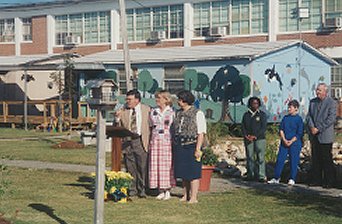
In all,
the project took an entire year to complete. Even with donations, the
project was an expensive one. We got donations from our city council
($30,000) a grant from the Junior League for the curriculum materials in the
Environmental Classroom ($23,000), and a grant from the Alabama Forestry
Commission ($7,600). We had two major school fund raisers. We made
$4,000 through selling seed packs and $!,600 through recycling aluminum
cans. In addition, the PTA donated about $3,000 and various individuals in
the community donation materials, time, labor and money. The final cost
for the project which included the gardens, the environmental classroom, and all
the curriculum materials and equipment was approximately $70,000.
The
Environmental Center has yearly maintenance costs. Gardens need additional
plants, the pond pump needs to be replaced every couple of years, new mulch is
purchased twice a year, and new things need to be added. We have a yearly
recycling campaign in which all funds are used for the environmental center
maintenance. In addition, our PTA provides approximately $1,500 per year
for maintenance such as lawn cutting during the summer.
Our
Environmental Center and Environmental Classroom won the "Best
Environmental School Project" for the state of Alabama in 1997.
Click
here to see more pictures of our Environmental Center!
Please click  to go HOME
to go HOME
 How
To Create A Pond
How
To Create A Pond  Our
Environmental Center
Our
Environmental Center
 Environmental
Center Classroom
Environmental
Center Classroom  Meet
Grandforest Tree
Meet
Grandforest Tree

 After the
initial landscape plan was created we looked at irrigation. Because our
environmental center was so large, we decided to have an automatic irrigation
system with six zones installed. This gives us control over when to water
and how long we will water each zone. The irrigation system is wonderful
because during the hot, dry summer months, we don't have to worry about someone
watering! The irrigation system was pretty expensive, but well worth
it.
After the
initial landscape plan was created we looked at irrigation. Because our
environmental center was so large, we decided to have an automatic irrigation
system with six zones installed. This gives us control over when to water
and how long we will water each zone. The irrigation system is wonderful
because during the hot, dry summer months, we don't have to worry about someone
watering! The irrigation system was pretty expensive, but well worth
it. 




